New Year’s Day, Tuesday 1st January – Silkstone Fall – The year starts damp and mild. The woods are saturated. Water is gushing out of the culvert that takes a stream deep under the track from the road. I collect some sodden kindling which will require considerable drying before it is any use. The woods are almost silent, just the occasional cheep or chirp.
Wednesday 2nd January – Fleets Dam – It is even wetter than yesterday, although not really raining, but much colder. Water pours at an increased rate over the weir. Mallard fly up from the river. The mild autumn and early winter is indicated by a fresh growth of Honey Fungus on a log lying by the pools. A small flock of Goosander have arrived on the lake and Mallard are flying in. Just a couple of Black-headed Gulls are checking whether the Goosander have anything edible.
Thursday 3rd January – Home – There has been the slightest dusting of snow overnight. It is cold and damp and I have another cold. The snow slowly disappears during the day, despite there being a fairly constant trickle falling. Six Magpies strut about the vegetable patch, poking at clods of earth, seeking food. I have put out stale mince pies and bread which have disappeared in a thrice – doubtless devoured by these black, white and metallic blue hooligans.
Friday 4th January – Home – It has become more mild but remains damp and grey. Dill the Dog is restless (unusual as she can rest for England these days). She cannot go through the kitchen to the garden as workmen are repairing some dodgy building work we had done some years back. So it is off to the green up the road. A flock of about thirty Starlings rises from a garden behind a wall. They alight in a Plane tree, chattering and whistling excitedly. A Collared Dove in the tree seems to ignore them. Then they are off, around the back of the houses and into another tree for just a moment before dashing off again. The green was built as a reservoir but it is said to have been covered over during the war to provide bomb shelters. It is now a basin of perhaps one hundred yards. One small area has subsided a little and become marshy which makes one wonder what is underneath. On the way back, House Sparrows chatter in a hedge a few doors up. It is good to see them around here, they have declined dramatically over the last decade.
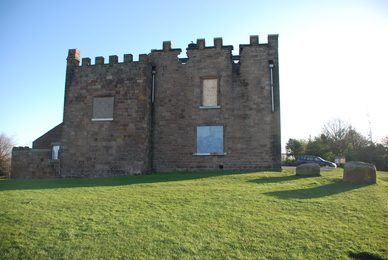
Wednesday 9th January – Rotherham – The Moorgate area of Rotherham is on high ground to the south of the town. The main road leads down to Whiston, past large Victorian houses, the General Hospital and the Thomas Rotherham College. It is beside the latter I park and head up past Moorgate Cemetery and into Boston Park. Inside the park is Boston Castle, standing on the edge of a very steep escarpment that overlooks Canklow, the River Rother, M1 motorway and on towards Sheffield. The castle is a square building erected by Thomas, 3rd Earl of Effingham as a hunting lodge in 1775/6. It has been 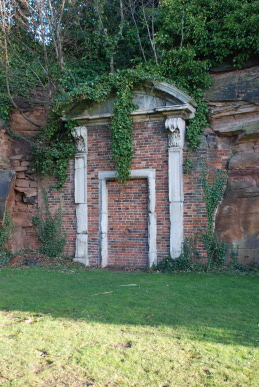 described as “the whimsical indication of the Earl’s sympathy with his transatlantic fellow-countrymen”, in that it is said to have been a mark of the Earl’s opposition to the British attempts to crush the American Revolution. It has been said that he forbade the drinking of tea (a reference to the Boston Tea Party, brought about by the British imposition of taxes on the colonists, including tea) in the building. The park is mainly open grassland leading up to a reservoir and two ugly communications masts, but a path leads down into a quaint bowling green set in an old quarry. The quarry provided a fine red sandstone known as Rotherham or Mexborough Red Rock. This stone can be seen in use in a number of Rotherham’s buildings, including the Parish Church. Set into the rock face is the doorway from Jesus College, founded by Thomas Rotherham in 1483 and was sited in what is now the main shopping area of the town. It is a pleasant day with bright sunshine although the strong wind creates something of a chill. A Wood Pigeon watches me as I pass through the old quarry. Back near the park entrance a Great Tit is calling and a Blackbird chukks in the bushes. The Moorgate Cemetery is Victorian. Currently officials are laying down any headstone that is deemed “unsafe”. This is happening throughout the country after some children managed to get themselves crushed under unstable headstones. It could be argued that parents could take some responsibility and stop their children pulling large slabs of stone on top of themselves, but in our present culture we would rather deface our graveyards. The chapel in the centre of the cemetery is clearly no longer used, its lead paned windows at the back mainly smashed.
described as “the whimsical indication of the Earl’s sympathy with his transatlantic fellow-countrymen”, in that it is said to have been a mark of the Earl’s opposition to the British attempts to crush the American Revolution. It has been said that he forbade the drinking of tea (a reference to the Boston Tea Party, brought about by the British imposition of taxes on the colonists, including tea) in the building. The park is mainly open grassland leading up to a reservoir and two ugly communications masts, but a path leads down into a quaint bowling green set in an old quarry. The quarry provided a fine red sandstone known as Rotherham or Mexborough Red Rock. This stone can be seen in use in a number of Rotherham’s buildings, including the Parish Church. Set into the rock face is the doorway from Jesus College, founded by Thomas Rotherham in 1483 and was sited in what is now the main shopping area of the town. It is a pleasant day with bright sunshine although the strong wind creates something of a chill. A Wood Pigeon watches me as I pass through the old quarry. Back near the park entrance a Great Tit is calling and a Blackbird chukks in the bushes. The Moorgate Cemetery is Victorian. Currently officials are laying down any headstone that is deemed “unsafe”. This is happening throughout the country after some children managed to get themselves crushed under unstable headstones. It could be argued that parents could take some responsibility and stop their children pulling large slabs of stone on top of themselves, but in our present culture we would rather deface our graveyards. The chapel in the centre of the cemetery is clearly no longer used, its lead paned windows at the back mainly smashed.
Sunday 13th January – Fleets Dam – Fronts move over the country on a daily basis, so one day is grey and wet, the next brighter. Today it is the former. Water pours over the weir creating a swirly bubble bath of foam at its base. A few Blue Tits squeak in the trees. The old willow in the carr has another branch bent over to almost tough the ground. The rupture can be seen near the trunk, where the fibres of wood are tearing. This has been happening to the tree for years, sawn stumps of branches are numerous on the old trunk. The lake seems deserted by all but anglers slumped under their umbrellas. Another episode of gout in my knee has greatly restricted my ability to walk, so I turn and head back to the car park, to the evident relief of Dill the Dog who is pretty uninterested in walking these days.
Tuesday 15th January – Dearne Valley – A short walk in town this morning quickly demonstrated I am not able to cover any distance on my knee. It is quite dark, the sky steel grey and delivering continuous rain. By the afternoon it has cleared slightly, but large grey rain clouds still predominate. Driving down Old Mill Lane I catch sight of 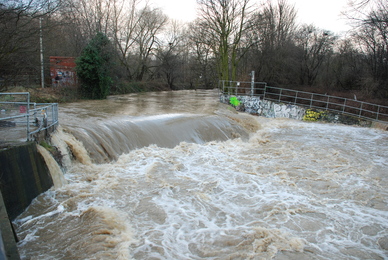 the River Dearne plunging over the weir. The river has risen considerably and a dirty chocolate torrent pours down the concrete drop. Round in Smithies Lane the dense scrub between the river and the track to the Fleets Dam is flooded and a quick glance upstream shows extensive flooding.
the River Dearne plunging over the weir. The river has risen considerably and a dirty chocolate torrent pours down the concrete drop. Round in Smithies Lane the dense scrub between the river and the track to the Fleets Dam is flooded and a quick glance upstream shows extensive flooding.
Monday 21st January – River Dearne – My knee is slowly improving, although the problem seems to be mechanical rather than gout. It has been raining heavily all morning and following a wet weekend there are flood warnings spread across the area. The River Colne, running through Huddersfield, is about to burst its banks. The Dearne has burst its banks in several areas, Darton has been affected again. 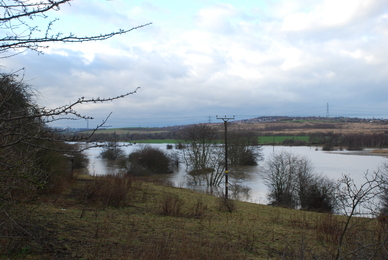 Down Old Mill Lane, the river pours over the weir in a wild torrent, whilst water drains off the fields lying towards the Wakefield Road. Upstream, the river is over the bank and flooding these fields. A tentative cheep from a Blue Tit is the only bird call to be heard. A pair of Great Crested Grebe are on the lake, but nothing else. Round in Smithies Lane, water covers a huge area up the valley. The course of the Dearne and the Loop have disappeared under a lake of grey. The river will have to rise by probably in the region of another five feet before it reaches last June’s levels but with the stormy clouds overhead this is a possibility.
Down Old Mill Lane, the river pours over the weir in a wild torrent, whilst water drains off the fields lying towards the Wakefield Road. Upstream, the river is over the bank and flooding these fields. A tentative cheep from a Blue Tit is the only bird call to be heard. A pair of Great Crested Grebe are on the lake, but nothing else. Round in Smithies Lane, water covers a huge area up the valley. The course of the Dearne and the Loop have disappeared under a lake of grey. The river will have to rise by probably in the region of another five feet before it reaches last June’s levels but with the stormy clouds overhead this is a possibility.
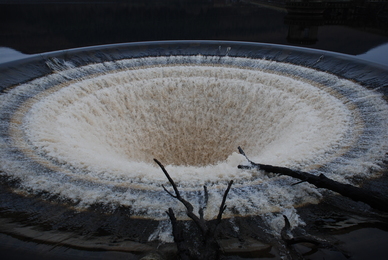
Tuesday 22nd January – Ladybower Reservoir – The Upper Derwent Valley cuts deep through the Pennines to the west of Sheffield. The Rivers Derwent and Ashop meet and are dammed to form the Ladybower Reservoir. The reservoir was built between 1935 and 1943, flooding the villages of Ashopton and Derwent and took two years to fill. It was formally opened by by King George VI and Queen Elizabeth on 25th 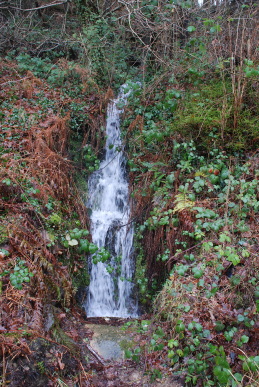 September 1945. Severn-Trent Water have provided a car park at Heatherdene near the north end of the water. We head off on the hillside through open woodland. Blackbirds, Chaffinches, Great and Blue Tits flit through the trees. A Robin is singing. The path drops down to cross the Bamford road, past the plaque celebrating the Royal opening of the reservoir and onto the dam wall. The pumping station is far below. It can handle 170 million litres of water each day. The Upper Derwent Valley reservoir system provides 10% of all the water supplied by the Severn-Trent Water Company. Tall trees stand near the pumping works and a Kestrel is sitting on top of one, looking down at the land below but still far below us. Near to each end of the dam wall, out in the reservoir are two large bellmouth overflows, locally called the “plug holes”. Water is cascading down them at a considerable rate. Standing looking down at the
September 1945. Severn-Trent Water have provided a car park at Heatherdene near the north end of the water. We head off on the hillside through open woodland. Blackbirds, Chaffinches, Great and Blue Tits flit through the trees. A Robin is singing. The path drops down to cross the Bamford road, past the plaque celebrating the Royal opening of the reservoir and onto the dam wall. The pumping station is far below. It can handle 170 million litres of water each day. The Upper Derwent Valley reservoir system provides 10% of all the water supplied by the Severn-Trent Water Company. Tall trees stand near the pumping works and a Kestrel is sitting on top of one, looking down at the land below but still far below us. Near to each end of the dam wall, out in the reservoir are two large bellmouth overflows, locally called the “plug holes”. Water is cascading down them at a considerable rate. Standing looking down at the 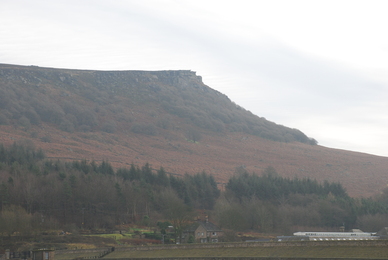 water pouring down gives a considerable sensation of vertigo. Above the reservoir are high hillsides – Winn Hill, a steep conical top, peeks out from behind them. On the other side of the valley is the curving Bamford Edge. The open moorland above the trees and below the craggy peaks is rusty red with dead Bracken. A carved panel stands at the end of the dam wall depicting water activities. The back is quite hidden away and has a nice carved map of the Derwent Valley. A track runs alongside the reservoir. Numerous water-courses pour down the hillside, most are channelled under the track but a few pour across. One hollow in the clay bank has only a little water dripping through brilliant emerald ferns. There is some sort of large raft out on the water which provides a platform for several Cormorants. We retrace our steps and then drive over Snake Pass. Kinder Scout is pale with a scattering of snow.
water pouring down gives a considerable sensation of vertigo. Above the reservoir are high hillsides – Winn Hill, a steep conical top, peeks out from behind them. On the other side of the valley is the curving Bamford Edge. The open moorland above the trees and below the craggy peaks is rusty red with dead Bracken. A carved panel stands at the end of the dam wall depicting water activities. The back is quite hidden away and has a nice carved map of the Derwent Valley. A track runs alongside the reservoir. Numerous water-courses pour down the hillside, most are channelled under the track but a few pour across. One hollow in the clay bank has only a little water dripping through brilliant emerald ferns. There is some sort of large raft out on the water which provides a platform for several Cormorants. We retrace our steps and then drive over Snake Pass. Kinder Scout is pale with a scattering of snow.
Thursday 24th January – Home – The morning starts with rain and greyness. A small flock of Redwings are in the apple trees, standing erect and surveying the garden. It is wet on the way to Penistone, even trying to turn to sleet. By the time we have finished shopping at the market, the sun is out and blue skies above. It is a surprising change of weather which continues throughout the afternoon. Dill the Dog is now on steroids to try and ease the stiffness in her back and hips. She seems to be moving a bit easier and her appetite has improved. However, yesterday the vet did offer the choice of putting her to sleep but I think her quality of life is still good enough to warrant keeping her going for a while longer.
Friday 25th January – The Old Salt Road – Salt seems to be the devil incarnate these days, exhortations to eat less salt, lo-salt this and that and advertisements declaring how little salt there is in their product. For centuries however, salt was a most valuable commodity. Apart from seasoning dishes, it acted as a preservative of both meats and vegetables, it acted as a medicine, such as salt gargles for throat infections and was used as a disinfectant, for example scrubbed into work surfaces to clean 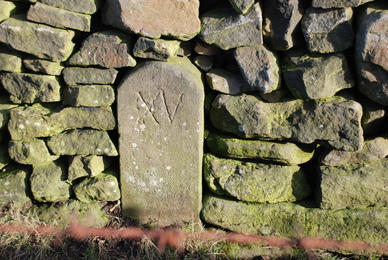 them after food preparation. It was traded all round the country. South Yorkshire’s salt came from the great mines of Cheshire. The Domesday Book records salt carts being pulled by oxen and horses and salt trains of horses. The route to Yorkshire ran from Northwich, through Altrincham, Reddish, Denton, Mottram, Tintwhistle and up Longdendale following the River Etherow. Here, the track rose steeply (and is still there) to the original Saltersbrook bridge, just below the present bridge on the A628, Woodhead Pass. I was hoping to visit the bridge but it is chaos as there are works on the road bridge, lorries parked on the only available parking spaces and traffic backed up in both directions. So I head back down the A628. The Salt Road ran slightly northwards of the present road, rejoining the modern road by the Dog and Partridge. This was a bleak crossing, even today with all the modern comforts of travel, the wind is blasting across the hilltop and it is easy to see how bad things could be
them after food preparation. It was traded all round the country. South Yorkshire’s salt came from the great mines of Cheshire. The Domesday Book records salt carts being pulled by oxen and horses and salt trains of horses. The route to Yorkshire ran from Northwich, through Altrincham, Reddish, Denton, Mottram, Tintwhistle and up Longdendale following the River Etherow. Here, the track rose steeply (and is still there) to the original Saltersbrook bridge, just below the present bridge on the A628, Woodhead Pass. I was hoping to visit the bridge but it is chaos as there are works on the road bridge, lorries parked on the only available parking spaces and traffic backed up in both directions. So I head back down the A628. The Salt Road ran slightly northwards of the present road, rejoining the modern road by the Dog and Partridge. This was a bleak crossing, even today with all the modern comforts of travel, the wind is blasting across the hilltop and it is easy to see how bad things could be  out there. John Hobson of Dodworth recorded that on the 13th of December 1726 the weather was so bad that several travellers had perished on the moors above Woodhead.
out there. John Hobson of Dodworth recorded that on the 13th of December 1726 the weather was so bad that several travellers had perished on the moors above Woodhead.
The road passes the Flouch, now by some distance as a new roundabout bypasses the old inn. John Addy records “On the road across the Pennines to Woodhead stood the New Inn built in 1827 by George Heward. However, the landlord had the misfortune to possess a hare-lip and it is believed that the inn became known as the “Slooch” which was corrupted to Flouch.” (A Further History of Penistone 1965). Much traffic turns here to head down to Sheffield, but the road ahead is the old Salt Road. A sharp bend takes the road off towards Penistone, but the straight road heads up Hartshead Hill. Just before the steep rise is a milestone marked XVI and height mark. This indicates 16 miles to Rotherham. Up the hill the road divides and the Salt Road follows the  Mossley Road. A short way along in a strange circular wood (called Ring Wood) enclosed by a circular wall. In the wall is another milestone, this time XV miles to Rotherham. Along Mossley Road is the junction with Mortimer Road. The latter was a road constructed in the 1770s by Hans Winthrop Mortimer, Lord of the Manor of Bradfield, who hoped to make a fortune from tolls from the road which was to link the Peak District with the woollen industry of the north. However, the venture failed and Mortimer died in straitened circumstances in 1807. The road starts to drop down towards Midhope at Sheephouse Height. Here is a stone inscribed “Take Off”. At the bottom of the hill, men or boys would wait with horses to hitch to any coach or wagon for a few pennies to help it get up the steep hill. The horses would be unhitched at the “Take Off” stone. Back on the Mossley Road, the name changes to Cranberry Road. The farm buildings just to the south of the junction was once the Cranberry Inn. Further on down the road is a junction with Dyson Cote Lane. On the junction is a rare hexagonal milepost, called a “stoop”. The faces show Barnsley and Doncaster 1734 Doncaster; Wakefield and Leeds; Penistone, Huthsrsfield and Hallifax; Woodhead and Mottram; Underbank and Bradfield; Sheffield and Rotherham. The stones would have been erected on the order of West Ridings Justices of Peace, sitting at Quarter Sessions. (Thanks to a splendid booklet published by Rotherham Council for much of the above information.)
Mossley Road. A short way along in a strange circular wood (called Ring Wood) enclosed by a circular wall. In the wall is another milestone, this time XV miles to Rotherham. Along Mossley Road is the junction with Mortimer Road. The latter was a road constructed in the 1770s by Hans Winthrop Mortimer, Lord of the Manor of Bradfield, who hoped to make a fortune from tolls from the road which was to link the Peak District with the woollen industry of the north. However, the venture failed and Mortimer died in straitened circumstances in 1807. The road starts to drop down towards Midhope at Sheephouse Height. Here is a stone inscribed “Take Off”. At the bottom of the hill, men or boys would wait with horses to hitch to any coach or wagon for a few pennies to help it get up the steep hill. The horses would be unhitched at the “Take Off” stone. Back on the Mossley Road, the name changes to Cranberry Road. The farm buildings just to the south of the junction was once the Cranberry Inn. Further on down the road is a junction with Dyson Cote Lane. On the junction is a rare hexagonal milepost, called a “stoop”. The faces show Barnsley and Doncaster 1734 Doncaster; Wakefield and Leeds; Penistone, Huthsrsfield and Hallifax; Woodhead and Mottram; Underbank and Bradfield; Sheffield and Rotherham. The stones would have been erected on the order of West Ridings Justices of Peace, sitting at Quarter Sessions. (Thanks to a splendid booklet published by Rotherham Council for much of the above information.)
Sunday 27th January – Home – The day of the Great RSPB Garden Bird Watch, an hour recording the population of birds in the garden. The count is pretty mediocre as I have not fed the birds this winter. As we had expected to move out before the winter and then at any time since, starting winter feeding seemed inadvisable as it may have ceased abruptly, which is not good news for any bird that has come to rely on the constant source of sustenance. In the event, we have not moved and may not until spring, but hindsight is always a wonderful thing! So there are just a few Blackbirds, Magpies, Wood Pigeons, Blue, Great and Long-tailed Tits, but no finches.
Willowbank – New public footpath signs have been erected down Smithies Lane indicating the various paths across Willowbank. I do not know if they have just been designated; they certainly have been used as footpaths for over twenty years. Several Bullfinches flash bright pink, black and white as they slip away through the Hawthorns. Down the hill the canal still looks very full, the Hawthorns at the foot of Willowbank are several feet out in the water. Large pools are lying on the fields beyond the River Dearne. A Sparrowhawk glides down the hill at tree-top height. After she has gone the chatter of tits and songs of Robins resumes. It is mild but there is still a strong wind. Normally this depresses the bird song but they must be feeling that spring is not so far away. A large Carrion Crow, black as night, hops across the dead tops of an old tree, cawing occasionally. Dill the Dog is moving quite well, although she will stop for interminable sniffing.
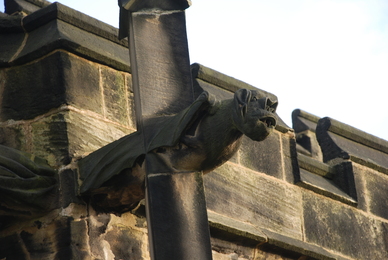
Tuesday 29th January – Silkstone – The church of All Saints is in the perpendicular of the 12th century, although it may be on the site of a Saxon church founded by Swein. The building was 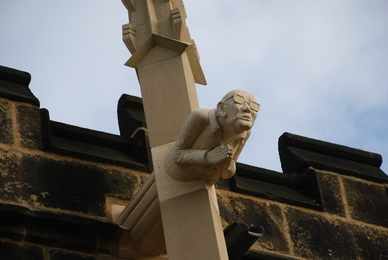 modified in 1495, and the chancel was rebuilt in 1852-1858. There are splendid gargoyles (or, to be accurate, “grotesques” as gargoyles proper are water spouts), some mythical beasts, others angels and holy people. Two have been replaced recently, two gentlemen, one with spectacles. The churchyard is extensive with some enclosed plots. One, oddly, has a a study cast iron fence and a large square construction which is barely readable. Otherwise there is a simple headstone and two much smaller ones with just initials carved on them. Another edifice in the shape of a barn has what was probably the headstone at one end but it is so eroded as to be entirely unreadable – so grand a tomb but unremembered! There is a modern plot towards the top of the cemetery where also stands a tall monument. On it is written:-
modified in 1495, and the chancel was rebuilt in 1852-1858. There are splendid gargoyles (or, to be accurate, “grotesques” as gargoyles proper are water spouts), some mythical beasts, others angels and holy people. Two have been replaced recently, two gentlemen, one with spectacles. The churchyard is extensive with some enclosed plots. One, oddly, has a a study cast iron fence and a large square construction which is barely readable. Otherwise there is a simple headstone and two much smaller ones with just initials carved on them. Another edifice in the shape of a barn has what was probably the headstone at one end but it is so eroded as to be entirely unreadable – so grand a tomb but unremembered! There is a modern plot towards the top of the cemetery where also stands a tall monument. On it is written:-
The idea that a merciful God would send forth a deluge that kills 26 people may seem strange and the admonishment and warning at the end harsh, but it all becomes rather more horrific when looking at the names recorded on the sides of the monument – 26 children from the  ages of 17 down to 7 years. 14 boys and 12 girls (who in death are still seen as inferior, it being noted that they were buried at the boys’ feet) were killed when the Huskar pit flooded. There is, of course, no remonstration of a pit owner that sends 7 year old children to their death. However, one positive of this tragedy is that after an official enquiry led by Lord Shaftesbury it was made illegal for woman and children to work in mines. We leave this depressing site and head down the hill. There were two Methodist chapels here, one Wesleyan and one Primitive. The former is now a nursery and the latter a storehouse for a local plant nursery. The Red Lion Inn has been here since 1733 and its was where the inquest into the deaths of the children killed in the Huskar Pit disaster was held. A footpath runs off the road here up to Whin Moor through a wood down which runs a small stream. The wood is flanked by modern housing estates now. The path arrives at an open field from which Noblethorpe House, home of the pit owner Robert C. Clarke, can be seen.
ages of 17 down to 7 years. 14 boys and 12 girls (who in death are still seen as inferior, it being noted that they were buried at the boys’ feet) were killed when the Huskar pit flooded. There is, of course, no remonstration of a pit owner that sends 7 year old children to their death. However, one positive of this tragedy is that after an official enquiry led by Lord Shaftesbury it was made illegal for woman and children to work in mines. We leave this depressing site and head down the hill. There were two Methodist chapels here, one Wesleyan and one Primitive. The former is now a nursery and the latter a storehouse for a local plant nursery. The Red Lion Inn has been here since 1733 and its was where the inquest into the deaths of the children killed in the Huskar Pit disaster was held. A footpath runs off the road here up to Whin Moor through a wood down which runs a small stream. The wood is flanked by modern housing estates now. The path arrives at an open field from which Noblethorpe House, home of the pit owner Robert C. Clarke, can be seen.
Wednesday 30th January – Wortley – Starting out from Cote Green car park, part of the Trans-Pennine Trail. Cote (or as in the mid 19th century Coates) Green is close to the old Wortley Station, visited last September, but this time I head north-west along a track through open fields. Robin song can be heard along the railway bank trees. It is a gloriously sunny day but the wind is bitter, even through two layers of fleece. A path leads off up towards woodland to the west. The path passes through fields occupied by horses in voluminous overcoats. Along the edge of the woods is a ride for horse jumping. The woods form the ridge to the west of the Halifax Road ridge on which Wortley and Thurgoland villages lie. I move through the trees and are suddenly faced by a precipitous drop, crags known as Raven Rocks. The woodland below is Hey Crook Common and beyond the meandering River Don. A wall lies buried in dead bracken with a single large flat stone, like a Stegosaurus back-plate, sticking out of the earth. I continue through the woods but discover that there is no way down above Wortley Top Forge. I retrace my steps and head down a field towards the track I originally left. Redwings, Mistle Thrushes and a Fieldfare are feeding in the winter wheat. The end of the field is adjacent to a row of cottages and outbuildings, the latter shown on the mid 19th century map as a chemical works. Jays are noisy overhead, flapping through the tall Beeches. From the cottages a path leads through woods, Forge Wood, beside the river. Workers are banging around in the forge, now an exhibition. A large lake fed the forge, Back Dam, now a popular angling venue. Drainage dykes but deep into the hillside, the path meanders up and down to cross them. Below one culvert is a ditch with bare tree roots crossing from one side to the other. Beside the path are the first shoots of Bluebells. A muddy path just before the river heads west again leads up to the railway, the Sheffield-Penistone line which is the Trans-Pennine Trail. I rest by a bridge on some simple but pleasant benches. From here, looking north-west a row of old cottages reside on the hill above where the river bends. It appears this area is part of Thurgoland, but seems once to have been called Moorcock, then Mount Pleasant. A Long-tailed Tit moves through the tree tops which are now at eye level. It is now a simple and flat walk back to Cote Green.
Thursday 31st January – Penistone – Awake to a gale and hailstones banging on the windows. However, by mid-morning it seems to be clearing. Soon as we head off to Penistone it starts raining again. A rainbow stretches across Redbrook but when we get to Barnby Bridge and stop to take a photograph it disappears! In Penistone the wind is howling across the recreation field and into the market. Many traders have taken the day off. Ray has parked his van hard against the auction shed, but it is still rocking. The flower man has not unloaded and is serving the few souls braving the wind and rain from the back of his van. Back home and by lunchtime the sky is blue, but there is still a gusty wind. At around 2:30 in the afternoon it starts snowing.